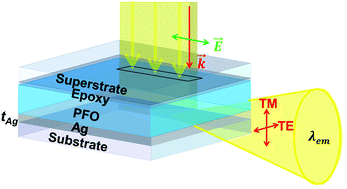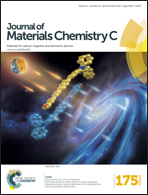Effects of metal film thickness and gain on the coupling of organic semiconductor exciton emission to surface plasmon polaritons†
Abstract
Control of near-field exciton emission coupling to surface plasmon polaritons (SPPs) is of importance for the development of efficient organic semiconductor thin-film light sources. Here, we experimentally investigate organic exciton emitter–SPP coupling in insulator–semiconductor–metal–insulator (ISMI) waveguides, containing an organic semiconducting (i.e., conjugated) polymer film on a range of Ag metal film thicknesses, as a function of optical excitation pump power and collection polarization. An increase in transverse-magnetic-polarized emission peak intensity is observed as a function of decreasing metal film thickness from ISMI waveguides at high excitation powers, suggesting more efficient emitter–SPP coupling for thinner Ag films when the polymer undergoes stimulated emission. Furthermore, emission dichroic ratio values (defined as the ratio of transverse electric to transverse magnetic polarized emission) increase when the polymer undergoes stimulated emission for thicker metal films but decrease below a certain metal film thickness. This indicates that gain in the semiconducting polymer film reduces the extent of exciton emission coupling to SPP modes for thicker metal films. However, once the metal thickness is below a critical value, gain improves exciton–SPP coupling. These results are consistent with theoretical calculations, which show that the dominant SPP mode exhibits a greater propagation length for thinner metal films, suggesting greater near-field overlap between the semiconductor film and SPP modes.


 Please wait while we load your content...
Please wait while we load your content...